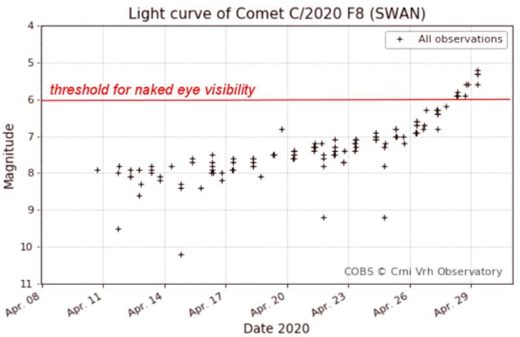Now Visible in NZ skies!
“the comet is little more than a dim fuzzball to the human eye. The view through a telescope, however, is stunning.”
Space Weather
Thu, 30 Apr 2020 © Gerald Rhemann

Comet C/2020 F8 SWAN taken on April 27, 2020 @ Farm Tivoli, Namibia
Comet SWAN (C/2020 F8) is brightening rapidly. “I just came in from observing it with the naked eye,” reports John Drummond of Gisborne, New Zealand. “It seems to have increased in brightness dramatically since I last saw it a few nights ago.” Indeed, multiple observers have now pegged the comet at magnitude +5.5, just within the range of naked-eye visibility.
At the moment, the comet is little more than a dim fuzzball to the human eye. The view through a telescope, however, is stunning. Gerald Rhemann sends this picture from Farm Tivoli, Namibia.
“This is a 30 minute exposure through my 12-inch Astrograph,” says Rhemann, who also made a magnificent animation of the comet. In only 40 minutes of tracking, it is possible to see complicated waves and tendrils of gas rippling down the comet’s tail. Play the movie.
The comet’s tail is so long, Rhemann could not fit it in the field of view. “In my photo it measures about 1.2 degrees long,” he says. “However, I know from friends who have photographed wider fields that it actually stretches about 8 degrees across the sky.” For comparison, the bowl of the Big Dipper is 10 degrees wide.

Above: The light curve of Comet SWAN courtesy of the Comet Observation Database (COBS).
Comet SWAN will make its closest approach to Earth on May 12th at a distance of 0.56 AU. That’s not very close, but it could be a good show anyway. If current trends continue, the comet will brighten to 3rd magnitude or better, similar to the stars of the Pleiades. Observers in the southern hemisphere will have little trouble seeing it as it glides through the constellation Pisces.
Much about Comet SWAN remains unknown. It was discovered only a few weeks ago, on April 11th, when a sudden hydrogen dump by the comet made it show up in data from the Solar and Heliospheric Observatory’s SWAN instrument. Comet SWAN’s hyperbolic orbit suggests that it might be a first-time visitor to the inner solar system. Such newcomers are notoriously unpredictable, so no one can say for sure what will happen next. Stay tuned! SOURCE

Get your copy from our Online Store or your local book and magazine retailer
Australian Retail Locations » Uncensored Publications Limited
New Zealand Retail Locations » Uncensored Publications Limited
As censorship heats up and free thought becomes an increasingly rare commodity, we appeal to our readers to support our efforts to reach people with information now being censored elsewhere. In the last few years, Uncensored has itself been censored, removed from the shelves of two of our biggest NZ retailers – Countdown Supermarkets and Whitcoulls Bookstores – accounting for 74% of our total NZ sales.
You can help keep the Free Press alive by subscribing and/or gifting a subscription to your friends and relatives.








